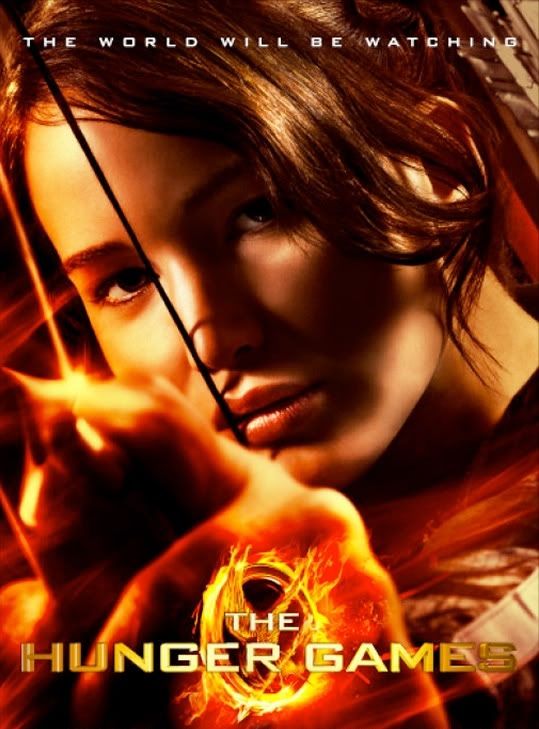As Jane Austin would say, it is 'a truth universally acknowledged’ nowadays that bestselling teen novels must be given the big screen treatment. After all, teens comprise the single largest movie-going demographic, which explains why PG-13 had been the most common rating in movies for decades. With the success of the maga-hit 'Harry Potter' and 'Twilight' franchises, it is hardly surprising that Suzanne Collins's hugely popular 'The Hunger Games' trilogy is the latest Hollywood bonanza. This movie's 'reaping' (no pun intended) in more than $200 million over its first two weekends only served to further validate Hollywood's continuing infatuation with young adult fiction. Ka-ching!!! Take that to the bank!
The premise of 'The Hunger Games' certainly isn't new, which is fine because virtually nothing's been new in Hollywood for a long time and as time goes by fewer and fewer original ideas remain. The important thing is to put a 'fresh twist' on a familiar theme, right? And 'The Hunger Games' managed to do just that, putting a new spin on our age old fascination with the ever popular bloodsport. While other similarly themed movies such as 'The Running Man,' 'The Tournament,' and its nearest sibling 'Battle Royale' have all 'been-there-done-that,' 'The Hunger Games' nonetheless portrayed a fascinating and vividly painted fascist dystopia of the future in which it poses the question: 'Are we any different than the "civilized" Roman citizens who cheered on at the Coliseum as their favorite gladiators hacked each other to pieces?' And the movie's references to ancient Rome are many. When the 24 tributes from the 12 Districts enter Panem to the cheer and adulation of the masses for the first time, they ride triumphantly in chariots like victorious Roman generals returning from a long but successful military campaign through the gates of Rome. The popular 'tributes' (the term itself sounds Roman doesn't it?) have backers (sponsors), much like the gladiators did in Rome, and they're wagered on just like gladiators used to be. Many characters in 'The Hunger Games' have decidedly Roman names, including the 'career' tribute from District 2 and the villain in the movie named Cato.
Typically movies based on books I've read seldom meet my higher expectations, but 'The Hunger Games' succeeded in this regard. In fact, I enjoyed it even more than the Suzanne Collins novel, because it had nuances and great acting (mainly from the lovely Jennifer Lawrence) that the book lacked. Surely, the book has more detail in many areas, especially background stuff which the movie could only gloss over in brief flashbacks, but the movie covered what it had to precisely in its two-and-a-half hour length and stands well on its own. As I mentioned before, the strength of the movie derived from its strong and believable characterization. After her star-turning role in the excellent 'Winter's Bone,' Jennifer Lawrence was perfectly cast as heroine Katniss Everdeen, the huntress from District 12 who gave herself to 'The Games' in order to save her beloved little sister's life. Sighting down her tightly drawn bow with arrow notched--see pic below, Katniss looked like Artemis (or 'Diana' according to the Romans) incarnate, the Goddess of the Hunt in Greek mythology. Yet this shimmering beauty with the soft eyes and luscious lips projects a vulnerability that is near impossible to resist. No wonder Peeta and Gale both harbored affections for her. Woody Harrelson provided a degree of poignancy and humanity as her mentor Haymitch, and Elizabeth “May the odds be evah in your fayvah!” Banks was simply mahvelous as Effie Trinket, a kind of "Joker-meets-The Mad Hatter" in female guise.
The movie deviated in minor details from the book, mostly for the better. One of the key changes (warning, spoiler ahead) is near the end, when the 'wolves' employed were the more traditional snarling quadrupeds, not the intelligent bipedal hybrid creatures genetically engineered from the 9 dead tributes as described in the book. The love triangle between Katniss, Gale and Peeta was given its due, but it's something that the movie could have done without. What is it with these love triangles anyway? First 'Twilight' and now 'Hunger Games'? Women!
There are those who didn't like the fight scenes in the movie, which were shaky close-up cuts and rapid choppy edits, but I have no problem with it because: 1) I'm used to it, and 2) it properly conveyed the sense of urgency and chaos in hand-to-hand close quarters combat. This well used method has been fairly common in movies since its introduction in 'Saving Private Ryan'and 'Gladiator'so many years ago.
9 out of 10 (an extra point just for looking so good while pulling that bow, Jennifer)


No comments:
Post a Comment